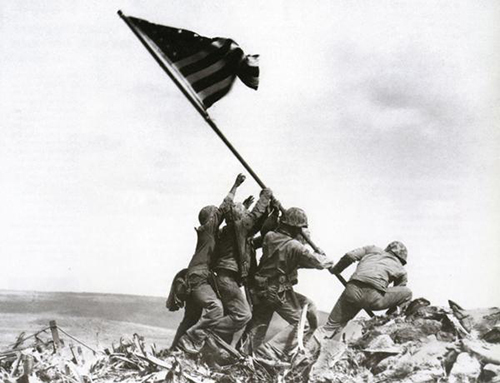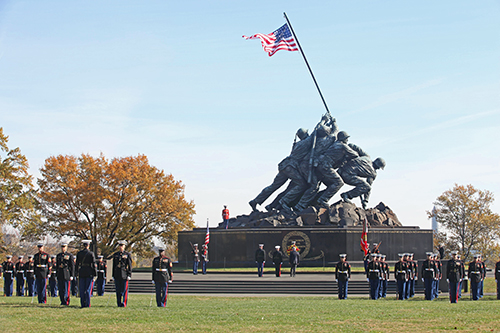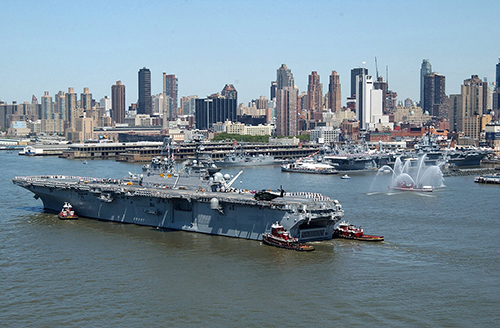The Battle of Iwo Jima
The Marine Corps, more so than any other branch of America's military, values and embraces its history. Beginning in boot camp, every Marine is educated on the Corps' proud and storied past as they learn what it means to be part of such a prestigious organization. In the spirit of the value the Marine Corps places on its history, we wanted to give you, Marine families and supporters, an opportunity to embrace and learn about this part of Marine Corps legacy as well. In this piece, we take a further look at one of the defining chapters in Marine Corps history - The Battle of Iwo Jima.
Iwo Jima
February 23 marks the anniversary of one of the most iconic moments in Marine Corps history and in all of World War 2--the American flag being raised over Mt. Suribachi during the Battle of Iwo Jima.
Background
By February of 1945, the United States Marine Corps had been fighting Imperial Japanese forces across the Pacific for three years. As the Marines slowly but surely worked their way across the Pacific in their island-hopping campaign and closed in on the Japanese homeland, the already fanatical Japanese resistance intensified, leading to some of the of the most brutally intense fighting in a campaign known for it ferocity.
Battle Summary and Flag Raising
The Battle of Iwo Jima began on February 19,1945, as more than 70,000 US military personnel, including approximately 60,000 Marines, attempted to capture the island of Iwo Jima from just over 22,000 Japanese troops. The operation was initially supposed to take 10 days, but a system of caves, tunnels, and bunkers on the island had shielded the Japanese defenders from the American artillery bombardment prior to American forces landing on the beaches. The Marines did not come under fire while landing on the beaches as they typically did, leading some to speculate that the artillery bombardment had been a success. It was only after the Marines had landed with their equipment and started patrolling into the interior of the island that the Japanese opened fire. It quickly became apparent that the bombardment had not been as successful as hoped and that operation was going to take longer than expected.
After four days of brutal fighting, the Marines had effectively cut off Mt. Suribachi ("Sulfur Mountain" in Japanese and the island's highest point) from the rest of the island. Despite being isolated above ground, American forces knew that the mountain was connected to Japanese defenders through the island's tunnel system, and thus had some strategic value. Two four-man Marine patrols were sent out to scout potential routes up the mountain, which they successfully accomplished after coming under far less enemy fire than anticipated. After the scout patrols descended the mountain and reported on the lack of enemy contact, USMC Colonel Chandler Johnson called for a platoon of Marines to climb back up the mountain and capture the summit. With the platoon, Johnson sent a small American flag to fly if and when they took the summit. The Marines again reached the top of Mount Suribachi without incident and, using a length of pipe they found among the wreckage atop the mountain, raised the flag, making it the first foreign flag to fly over Japanese soil.
Aftermath
Seeing the flag go up on Mt. Suribachi was a great morale boost, not only for Marines on the island, but also for Americans back home who saw Joe Rosenthal's iconic image of the flag being raised in news publications across the country. However, despite raising the flag on Mt. Suribachi after four days of fighting, the island wouldn't officially be declared "secure" until March 26, more than a month later, as the Japanese desperately did everything in their power to avoid surrendering, with less than 2% of Japanese defenders peacefully surrendering to American forces.
Legacy
Along with places like Belleau Wood, the Chosin Reservoir, and Hue City, the Battle of Iwo Jima is one of the iconic, defining events in Marine Corps history, as the Marines once again showed that they can fight, and persevere, no matter who or what stands in their way. Iwo Jima was also an anomaly in that it was the only battle in the Pacific Campaign in WW2 in which American casualties (more than 26,000) outnumbered Japanese casualties (18,844 killed, 216 captured). However, the Japanese suffered almost three times as many combat deaths as the Americans (almost 19,000 Japanese compared to 6,800 American).
When all was said and done, 27 Medals of Honor were awarded for actions on Iwo Jima, 14 posthumously. Of those 27, 22 were awarded to Marines and four were awarded to Navy Corpsmen attached to Marine infantry units. The 22 Medals of Honor earned by Marines on Iwo Jima represents more than 25% of the total number (82) of Medals of Honor earned by Marines in the entire Pacific campaign.
In the decades since 1945, Iwo Jima, and the summit of Mt. Suribachi in particular, has been a place of pilgrimage for Marines, many of whom leave dog tags, rank insignia, or other tokens in homage to the sacrifices made over those 36 days. Additionally, several ships have been commissioned USS Iwo Jima. Currently, USS Iwo Jima (LHD-7) is a Wasp-class amphibious assault ship that was commissioned in June of 2001.
February 23, 2015
Written by: Collin Hoeferlin
Communications Specialist
MarineParents.com, Inc.

This iconic photograph by Joe Rosenthal depicts five Marines and a Navy Corpsman raising an American flag atop Mount Suribachi during the Battle of Iwo Jima.
—National Archives and Records Administration photo

A wreath laying ceremony is held in honor of the 238th Birthday of the United States Marine Corps on Nov. 9, 2013, at the Marine Corps War Memorial in Arlington, Va.
—U.S. Marine Corps photo by Sgt. Marionne T. Mangrum

The amphibious assault ship USS Iwo Jima (LHD 7) pulls into Pier-88 after sailing up the Hudson River to kick off Fleet Week 2002 in New York City.
—U.S. Navy photo by Photographer's Mate 1st Class Michael W. Pendergrass.

